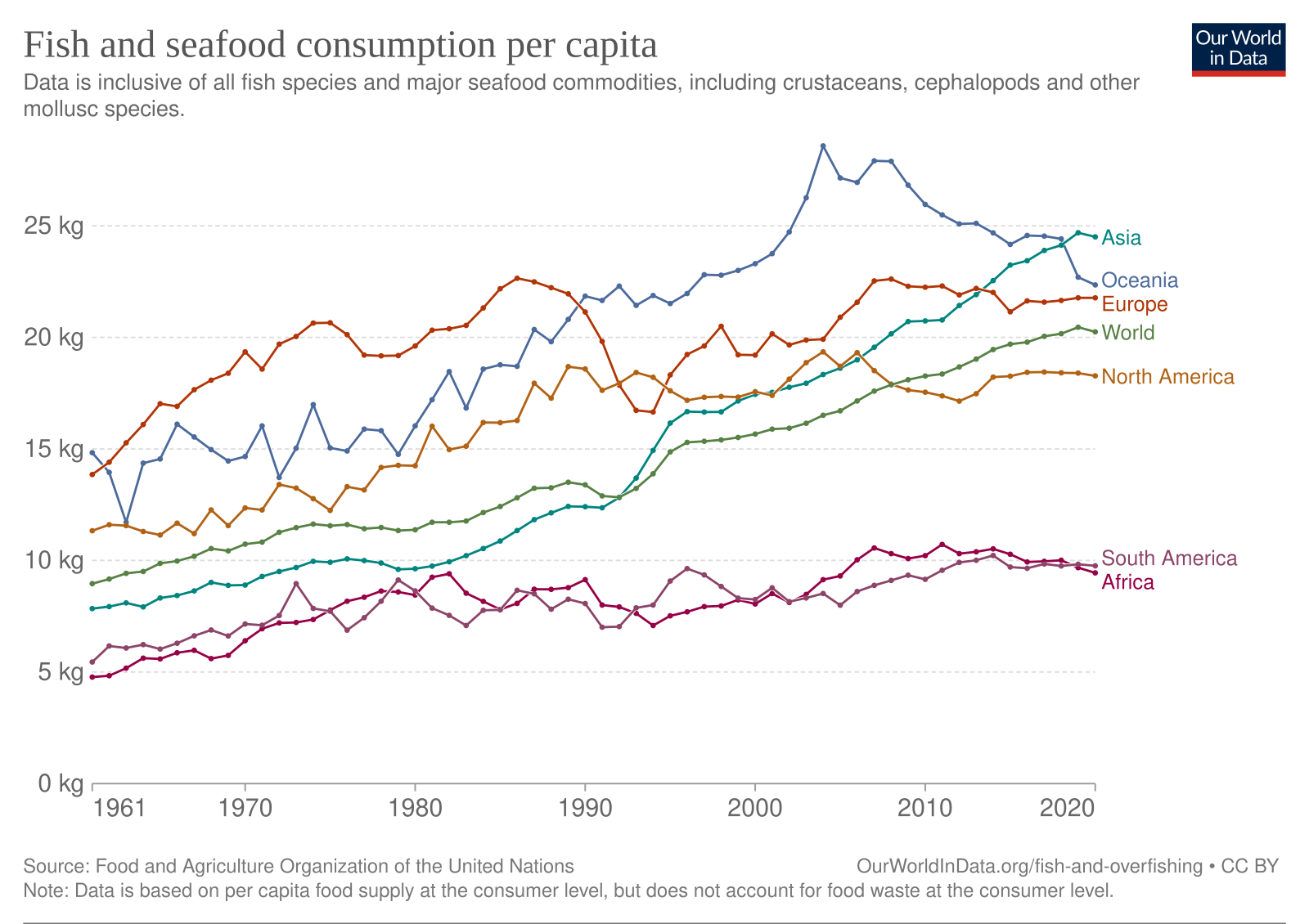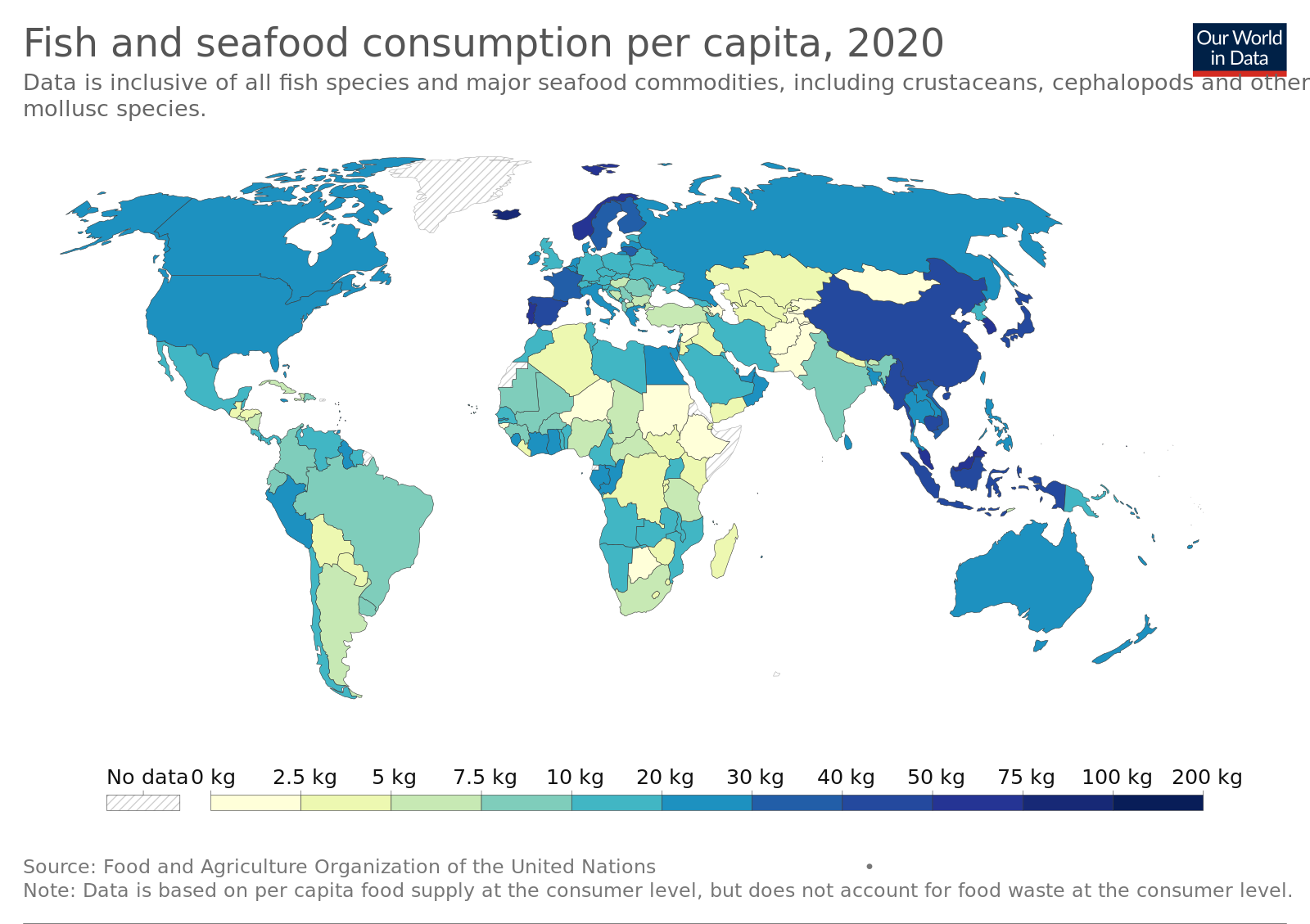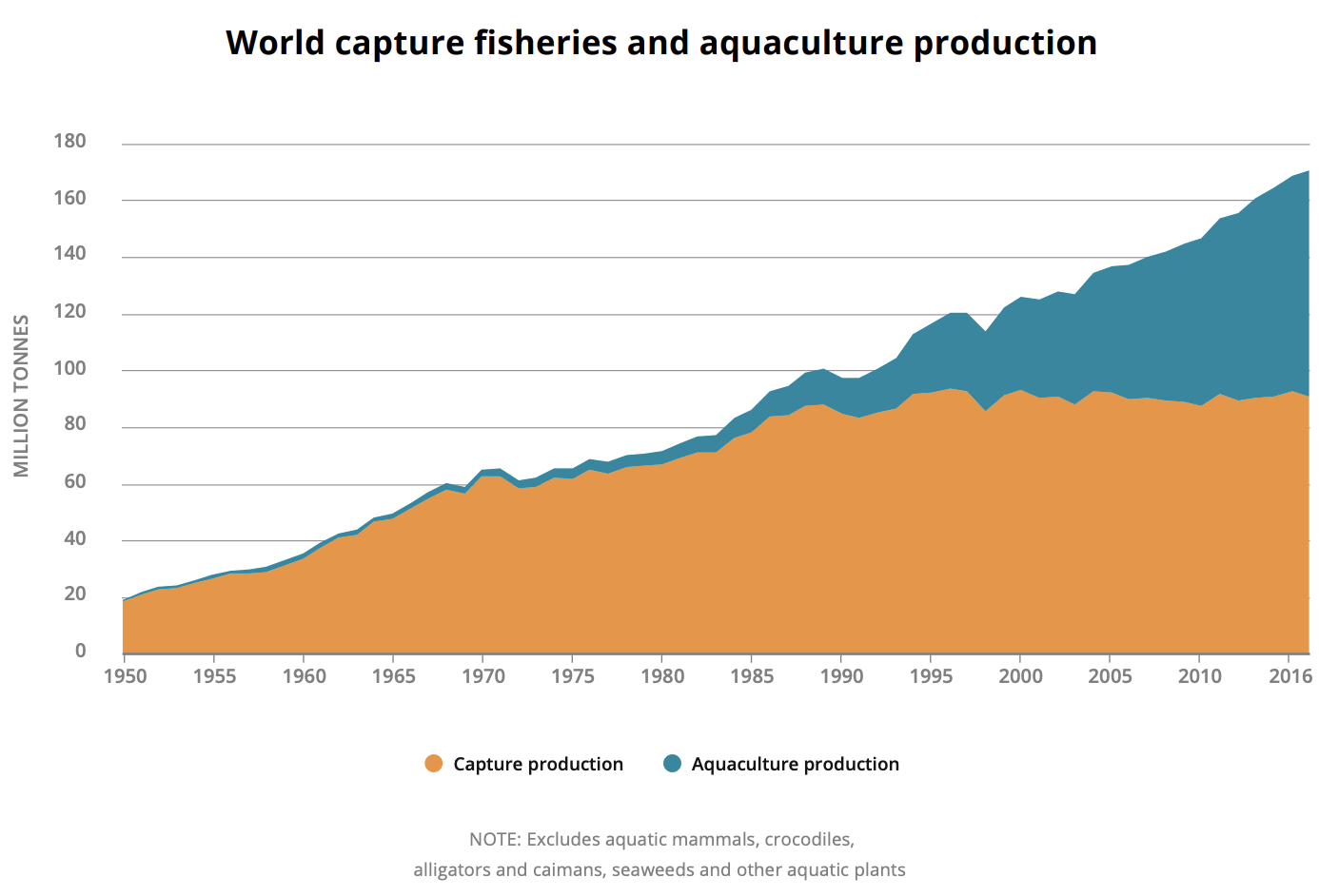IB Syllabus focus:
‘People harvest aquatic plants and animals locally and globally. Population growth and dietary shifts are increasing demand for aquatic foods.’
Aquatic food consumption is growing rapidly worldwide. Increasing global populations, shifting diets, and urbanisation drive demand for fish, shellfish, and aquatic plants across diverse societies.

Global time-series of fish and seafood consumption per capita showing a marked upward trend since the 1960s, consistent with rising demand. Values reflect apparent food supply at the consumer level. Source.
Global Consumption of Aquatic Foods
Aquatic foods form a critical part of human diets and livelihoods across the world. Fish, shellfish, seaweed, and freshwater plants supply essential protein, fatty acids, and micronutrients. They also play cultural and economic roles in many societies, providing livelihoods to millions of people.

World map of fish and seafood consumption per capita by country (kg/person/year), highlighting spatial differences that underpin local needs and global demand. Values represent apparent supply, which may include some waste at consumer level. Source.
Local vs Global Harvesting
Local harvesting: Traditional fishing and gathering in rivers, lakes, and coastal areas for community food security.
Global harvesting: Industrial fleets, aquaculture, and large-scale trade that link aquatic products to international markets.
As economic development continues, reliance shifts from purely local subsistence practices to a more interconnected global system of aquatic food supply.
Drivers of Rising Demand
Population Growth
The world’s population is projected to surpass 9 billion by 2050, creating heightened pressure on food systems. With more people, there is a natural increase in the demand for affordable and nutritious protein sources.
Population growth: The increase in the number of people living in a given area over time, usually measured as an annual percentage rate.
Population growth particularly intensifies demand in coastal and riverine regions where fishing is historically embedded in diets.
Dietary Shifts
In addition to sheer numbers, the nature of diets is also changing:
Rising incomes in developing economies increase demand for animal protein, including fish.
Urbanisation exposes populations to globalised diets, where seafood plays a prominent role.
Public awareness of health benefits of fish oils and omega-3 fatty acids contributes to a surge in consumption of oily fish and supplements.
Dietary shift: A change in the typical foods consumed by a population, often influenced by economic, cultural, or health factors.
Globalisation and Trade
International markets have expanded access to aquatic foods:
Global trade routes connect producers and consumers.
Frozen and processed seafood enables year-round consumption beyond local ecosystems.
High-value species such as tuna, salmon, and shrimp dominate global exports.
Implications of Rising Demand
Pressure on Wild Stocks
The increase in demand places intense pressure on wild fish populations. Overexploitation and unsustainable harvesting practices often follow when demand exceeds natural replenishment rates.
Expansion of Aquaculture
Aquaculture, or the farming of aquatic organisms, has expanded rapidly to meet consumption needs. While it increases supply, it can lead to environmental challenges such as habitat loss, disease spread, and pollution.
Aquaculture: The controlled cultivation of aquatic organisms such as fish, crustaceans, and plants, often in tanks, ponds, or coastal enclosures.
Aquaculture now accounts for over half of all fish consumed globally, illustrating its central role in food security.

FAO chart comparing capture fisheries and aquaculture production (1950–2016), demonstrating rapid aquaculture growth alongside stable capture harvests. This supports how rising demand is increasingly met by farmed production; the figure includes FAO dataset notes beyond syllabus requirements. Source.
Socio-Economic Dimensions
Employment: Millions of people, particularly in Asia and Africa, rely on fisheries and aquaculture for income.
Equity: Uneven access to aquatic foods can exacerbate inequalities between wealthier urban consumers and rural producers.
Cultural identity: For many communities, fishing practices are integral to heritage and traditions.
Regional Patterns in Consumption
Asia
The largest consumer and producer of aquatic foods globally.
Heavy reliance on fish for protein in diets.
Expanding aquaculture industry, especially in China, Vietnam, and India.
Europe and North America
Increasing demand for imported seafood, particularly exotic and high-value species.
Growing popularity of plant-based diets and sustainable seafood certification initiatives.
Africa
Dependence on freshwater fish such as tilapia and catfish for local food security.
Rising urban populations intensify reliance on imports due to limited local supply.
Environmental and Ethical Considerations
Resource Use
Rising demand drives overfishing and threatens aquatic biodiversity.
Expansion of aquaculture can cause habitat destruction and increase freshwater use.
Sustainability Concerns
Consumers and policymakers are increasingly aware of sustainability issues:
Eco-labels and certification schemes (e.g., MSC) encourage sustainable consumption.
Conservation policies aim to balance rising demand with protection of ecosystems.
Ethical Dimensions
Concerns about animal welfare in intensive aquaculture.
Exploitative labour practices in fishing industries, particularly on industrial fleets.
Linking Demand to Systems Thinking
In the IB Environmental Systems and Societies framework, the issue of aquatic food consumption and rising demand can be examined as a system:
Inputs: Solar energy, nutrients, and water.
Outputs: Fish, shellfish, and aquatic plants for human use.
Flows: Harvesting, trade, and consumption.
Feedback loops: Overfishing reduces stocks, triggering management interventions or shifts to aquaculture.
This systems perspective highlights how social, economic, and ecological factors interact to shape the future of aquatic food supplies.
FAQ
Increasing global demand often drives competition between industrial fleets and small-scale fishers. This can limit local access to fish stocks, raising prices and threatening food security.
However, in some regions, demand creates opportunities for small-scale producers to sell into global markets. The balance depends on governance, resource management, and equitable trade policies.
Asia accounts for the majority of global aquaculture due to:
High population densities creating strong local demand.
Availability of suitable coastlines, rivers, and deltas.
Government support for aquaculture as a food security strategy.
Cultural traditions of consuming freshwater and marine species.
This growth supports food supply but also increases risks of water pollution and habitat loss.
Advances in technology increase efficiency and sustainability in aquatic food production. Examples include:
Improved fish feeds reducing reliance on wild fish stocks.
GPS and sonar enhancing fishing efficiency.
Selective breeding for faster-growing farmed species.
Cold storage and transport systems enabling wider distribution.
Technology helps stabilise supply but can accelerate overexploitation if poorly managed.
Trade allows inland and landlocked nations to access diverse aquatic foods previously unavailable. This expands diets beyond traditional staples, integrating fish and shellfish into meals.
Such trade often raises demand for high-value species like salmon and tuna, increasing pressure on global stocks while also supporting cultural shifts towards protein-rich diets.
Medical research highlighting the benefits of omega-3 fatty acids and lean protein has influenced consumer choices. Many now view seafood as a healthier alternative to red meat.
Demand for oily fish, such as salmon, sardines, and mackerel, has grown as consumers seek cardiovascular and cognitive health benefits. Supplements derived from fish oils further amplify pressure on aquatic resources.
Practice Questions
Question 1 (2 marks):
Define the term dietary shift and explain how it contributes to rising demand for aquatic foods.
Mark scheme:
1 mark for correct definition of dietary shift: change in the typical foods consumed by a population, often influenced by economic, cultural, or health factors.
1 mark for explanation linking dietary shift to increased demand for aquatic foods (e.g., higher incomes, health awareness, urbanisation leading to more fish/seafood consumption).
Question 2 (5 marks):
Discuss two factors driving the rising global demand for aquatic foods, and outline one potential environmental consequence of this trend.
Mark scheme:
Up to 2 marks for identifying and explaining the first factor (e.g., population growth, urbanisation, global trade expansion).
Up to 2 marks for identifying and explaining the second factor.
1 mark for outlining one valid environmental consequence (e.g., overfishing, biodiversity loss, aquaculture pollution, habitat destruction).
Maximum 5 marks. Partial credit awarded where explanations lack depth but demonstrate relevant understanding.

